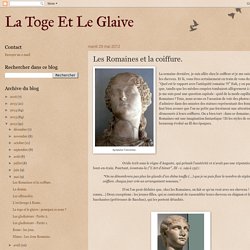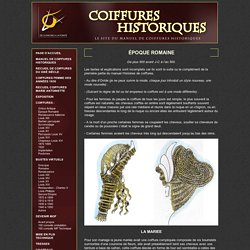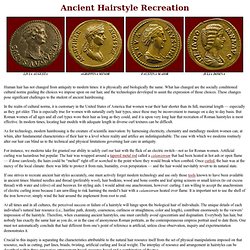

The "Tower" hairstyle: 2nd Century AD. Vestal Hairdressing: recreating the "Seni Crines" How To Do Ancient Greek Hair: Hair With Hollie - S02E5/8. Hairstyle and Costume of the Roman Bride. "Aphrodite knot" Ornatrix School: inside braiding. Comment se coiffer à la romaine? VIDEOS. The Woman Who Re-creates Roman Hair on YouTube. You can tell that hairdresser/archaeologist/YouTube personality Janet Stephens is an unusual woman by her choice of reading material: “I read Vogue and Bazaar for work, and I read scholarly work for entertainment,” she says.

Stephens styles hair at Baltimore’s Studio 921, but she’s better known outside of her hometown for tutorials faithfully re-creating historical updos on YouTube. She focuses mostly on the hairstyles of Roman women in the first century A.D. Few examples of ancient women’s hairstyling practices remain — given their feminine and quotidian nature, few were ever even recorded — but it is known that slaves called ornatrices styled rich women’s hair at home. Poor women likely employed friends or sisters to do their hair. No evidence exists that public, for-pay hair salons, like the one where Stephens works, existed in ancient Rome. Stephens wasn’t particularly interested in antiquities before a 2001 visit to Baltimore’s the Walters Art Museum. She was stumped. Quelques coiffures féminines de l'#Antiquite #RomeAntique #Mode. Les Romaines et la coiffure. La semaine dernière, je suis allée chez le coiffeur et je me suis fait couper les cheveux.

Et là, vous êtes certainement en train de vous demander : "Quel est le rapport avec l'antiquité romaine ?!! " Euh, y en pas ! Si ce n'est que, tandis que les mèches coupées tombaient allègrement à mes pieds, je me suis posé une question capitale : quid de la mode capillaire chez les Romaines ? Tous, nous avons eu l'occasion de voir des photos ou d'admirer dans des musées des statues représentant des femmes, mais il faut bien avouer que l'on ne prête pas forcément une attention démesurée à leurs coiffures. On a bien tort : dans ce domaine, les Romaines ont une imagination fantastique ! Coiffures GRECQUES. Coiffures ROMAINES. De plus 600 avant J-C à l’an 500.

Les textes et explications sont incomplets car ils sont la suite ou le complément de la première partie du manuel Histoires de coiffures. - Au dire d’Ovide (je ne peux suivre la mode, chaque jour introduit un style nouveau, une mode nouvelle) . - (Suivant le règne de tel ou tel empereur la coiffure est à une mode différente) . - Pour les femmes du peuple la coiffure de tous les jours est simple, le plus souvent la coiffure est naturelle, les cheveux coiffés en arrière sont légèrement bouffants souvent séparé en deux masses par une raie médiane et réunis dans la nuque en un chignon, ou en tresses descendantes le long de la nuque ou encore elles les entourent légèrement autour du visage. Ancient greek hairstyles by ninidu d5ppwmk. Ancient greek hairstyles vol 2 by ninidu d5ptqw3. Des coiffures de femmes romaines reconstituées à partir de momies d'Egypte.
Companion: Forensic Hairdressing. Human hair has not changed from antiquity to modern times: it is physically and biologically the same.

What has changed are the socially conditioned cultural norms guiding the choices we impose upon on our hair, and the technologies developed to assist the expression of those choices. These changes pose significant challenges to the student of ancient hairdressing. In the realm of cultural norms, it is customary in the United States of America that women wear their hair shorter than its full, maximal length — especially as they get older. Ornatrix School: needle skills.
Take Back Halloween! Related post: Last-minute Vestal Virgin (a pile of sheets and some yarn, basically) The Vestal Virgins were the six priestesses who tended the sacred flame of Vesta, goddess of the hearth, in ancient Rome.

They were far and away the most privileged women in Roman society, and in fact they were the only women who were granted the basic legal rights that male citizens possessed automatically. Unlike other Roman women, the Vestals could make wills, vote, and live free from the control of their male relatives. What they couldn’t do was have sex. Each Vestal took a 30-year vow of celibacy as a child, and the punishment for breaking that vow was death. But aside from the whole buried-alive thing, the Vestals enjoyed an enviable position at the top of Roman society. Our costume is based on ancient descriptions of the Vestals’ clothing, with a generous assist from the archaeologists and modern reenactors who have done so much to bring those descriptions to life. 1.
For the palla. . Roman Clothing, Part II. Women cannot partake of magistracies, priesthoods, triumphs, badges of office, gifts, or spoils of war; elegance, finery, and beautiful clothes are women's badges, in these they find joy and take pride, this our forebears called the women's world.

(Livy, History of Rome 34.5) In the above passage, Livy quotes a Roman tribune's argument for the repeal of the Oppian Law, a wartime measure which curtailed the finery that upper-class Roman women could display and which provoked the first recorded protest demonstration by women, as aristocratic Roman matrons took to the streets in 195 BCE to urge repeal of the law (click here for the context of this passage). As the tribune pointed out, high-class Roman women did not have the same distinctions of clothing that immediately marked out the status of their male counterparts; in fact the only certain distinction of dress allowed to women was the stola, which indicated a woman's marital status, not her social class or wealth.
Image List Barbara F. Deguisement.pdf. Fabriquer ses Caligae. To make authentic caligae one must first find an authentic cutting pattern.

Above is illustrated the best that I've so far located, taken from the book, "Stepping Through Time", the cutting pattern for the so-called Valkenburg/Castleford caliga and a pattern that I made for the Mainz variant. Click on the following link for an example of the Mainz variant: Mainz. Comment fabriquer ses boucles d'oreilles (vidéo en anglais)